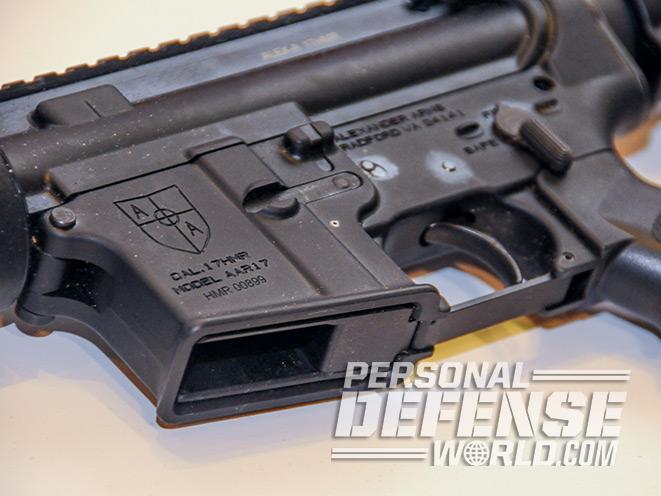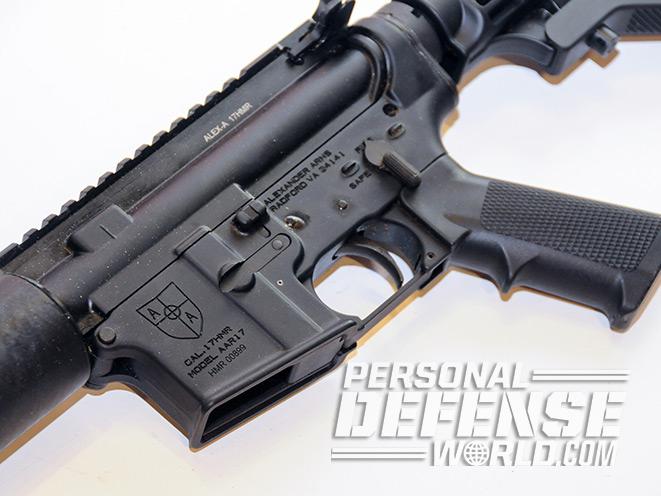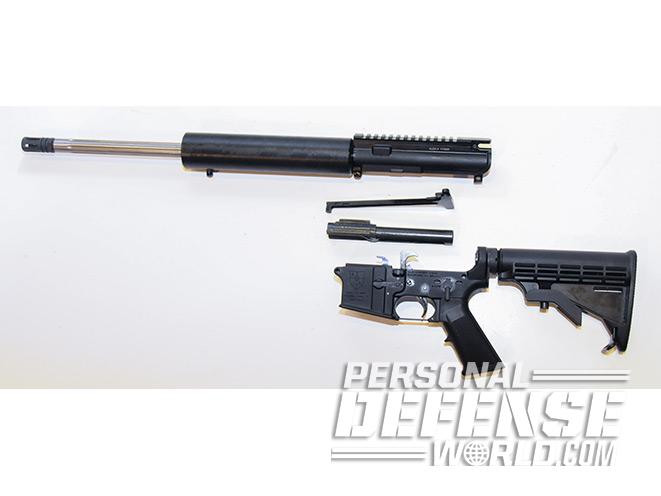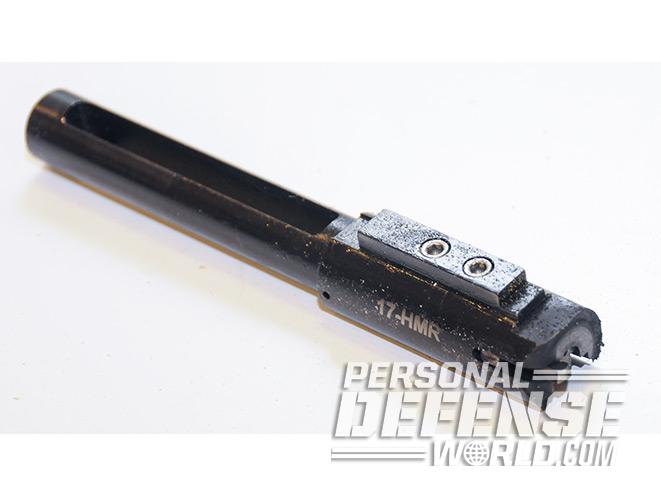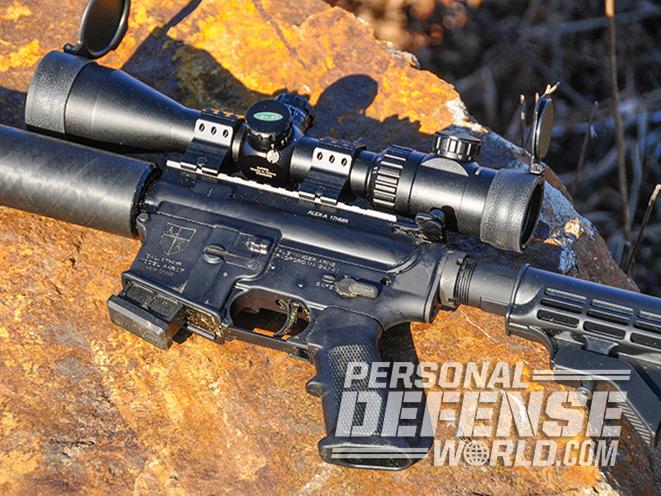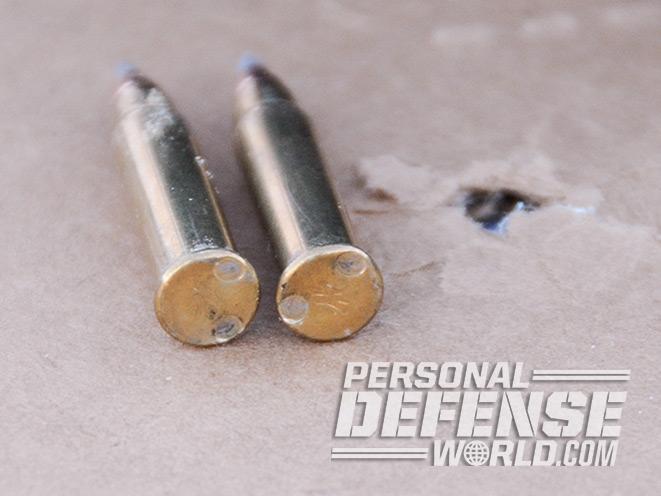Rarely is something AR related truly novel anymore, and rarely is a rifle this much fun to shoot. Alexander Arms has managed these two extraordinary feats somewhat quietly with several rifles, almost as if shaking up the modern sporting rifle world is the company’s day job, which, actually, it is. And it’s extremely good at it. Case in point is Alexander Arms’ AR-pattern .17 HMR, which is so humble it doesn’t have a special name or designation, just a catalog number. But boy, does it do some work out in the country.
Alexander Arms was founded by Bill Alexander, a top armorer from the United Kingdom who has extensive experience developing firearms, ammunition (he invented the .50 Beowulf and co-invented the 6.5 Grendel) and armor, giving him experience in both improving armor and defeating it in new and curious ways.
He moved to America to pursue the creation of his own design and manufacturing firm, to produce truly innovative firearms chambered for the cartridges he created (and a few standard ones, too). Fifteen years on, his company, Alexander Arms, with its manufacturing facility on the Radford Arsenal in southwestern Virginia, produces AR-pattern rifles chambered for .50 Beowulf, 6.5 Grendel and 300 Blackout. Bill and his team have had plenty of successes already by making non-standard cartridges work extremely well in the AR platform.
Advertisement — Continue Reading Below
Now they’ve moved into rimfires, choosing to adapt the AR platform to the hot little .17 HMR cartridge instead of the obvious .22 LR. Why? Because it gives the market an amazingly versatile platform for that cartridge as its popularity spreads through the sporting community. Also, not insignificantly, to see if they can do it. And boy, can they ever.
Varmint Hunter

Hornady and Winchester push their 17-grain .17 HMR projectiles to 2,550 fps. CCI pushes its projectile to 2,650 fps. Despite the projectile’s weight, that’s good for 246 foot-pounds of energy for the Hornady and Winchester loads, and 265 foot-pounds for CCI.
Advertisement — Continue Reading Below
Those cartridges each feature polymer-tipped projectiles that offer explosive (figurative) expansion because they have to. The .17 HMR is designed to be used against varmints and effective against coyotes and similar-size creatures. There’s not much projectile-stopping mass to a prairie dog or a squirrel, and not much distance in which to stop it, either. Thus, the projectiles are designed to immediately expand upon contact, to transfer as much energy into the target as possible during its brief passage through the target. The results on small game are devastating and best applied to pest control, where you don’t intend to eat what little is left.
RELATED STORY: Gun Review – Savage Arms Model 25 Walking Varminter Camo
We learned this when taking the Alexander Arms .17 HMR afield on a squirrel hunt to test its all-around handling. The rifle performed like a dream, displaying the characteristics we love about fielding AR-pattern rifles: their relative light weights, easily manipulated fire controls, instinctive pointing and their ability to hold position off-hand as targets slow down to afford a shot. I collapsed the stock one position from its length during zeroing to accommodate a heavy winter coat, and the triggerguard had no problems accommodating thin gloves.
Advertisement — Continue Reading Below
The .17 HMR cartridge did an excellent job of dispatching a trio of squirrels, with a few shots overperforming by removing a bit too much of the already meager amount of meat we were after. For pest control, though, the more destructive the terminal performance the better, and the .17 HMR provided plenty of that.
Rimfire AR

This rifle is a blowback-operated semi-automatic that accepts 10-round, detachable magazines. The polymer mags are shorter, narrower and skinnier than standard magazines, so the mag well has a flush-fitting sleeve that is pinned in place and not intended to be removed.
Advertisement — Continue Reading Below
The bolt is a clever unit that combines both bolt and bolt carrier group into a single piece of metal that rides inside the upper receiver, with a rimfire-style bolt face and massive extractor claw. A milled metal bar bolts to the top, providing a stepped face that can interact with the charging handle for manually retracting the bolt. The rear of the bolt features a large oval relief just like on the carrier in an AR, through which the hammer swings to impact the rear of the firing pin.
RELATED STORY: 20 Modern Rimfire Rifles From COMPLETE BOOK OF RIMFIRES 2015
There is no rotating bolt head, no cam and none of the complexity of an AR’s bolt carrier group largely because the .17 HMR has a lower operating pressure and much less kinetic energy to cycle such lockwork, and partly because it’s not needed to hold the bolt closed quite so long as with 5.56mm ammunition. The bolt begins its rearward journey after the cartridge’s rearward energy overcomes its inertial resistance to motion, and the case’s pressure goes down just enough to unstick it from the chamber. Then the whole unit lurches rearward, partially into the receiver tube—just like on any other AR—and is then driven home under spring pressure, stripping a new round from the magazine in the process.
Advertisement — Continue Reading Below
As with any blowback design, this means the receiver gets regular blasts of hot air with unburned powder, but this rifle receives no more so than any other blowback rifle. Possibly less, actually, with the added mass of this very large bolt keeping it closed just that tiny bit longer.
Charging the rifle is the same process as on any AR—via the charging handle beneath the receiver-length Picatinny rail. The safety and magazine release are also the same as you would expect from an AR. The only other significant outward differences are the lack of a forward assist on the starboard side and a lack of a bolt release on the port side. (The bolt is not held open after the last round has been fired, so there is no need for one.)
Range Time
Advertisement — Continue Reading Below
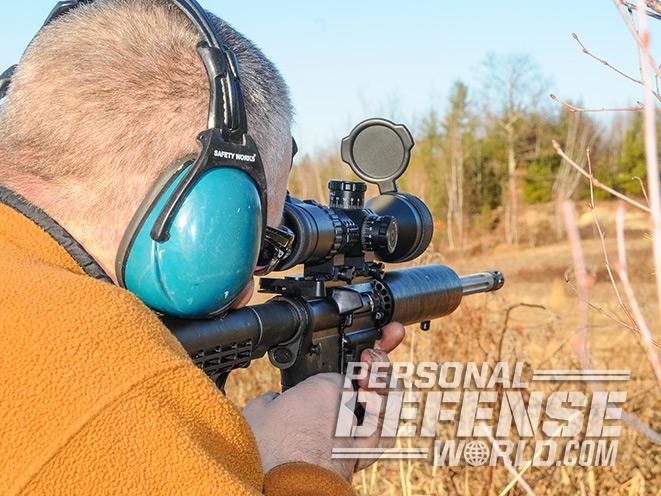
We experienced only two quirks during all of our testing. When the rifle arrived, the rear receiver pin was standing proud by the exact thickness of the receiver’s left wall. No amount of pushing or wiggling got it into place, so, daring fate, we tested the rifle with the pin not completely seated. It worked just fine, and if the rifle were ours, we’d just bang it in there with a hammer and be done with it.
The other issue was the 2-percent failure rate of the Winchester ammunition. It was a consistent two out of every hundred that failed to ignite, over the course of roughly 400 rounds. The suspect duds were run through again, rotated so the firing pin would hit a different part of the rim. None of the first-time duds ignited with the second strike, absolving the rifle. Since the ammunition was all from the same batch, it’s likely an anomaly.
Advertisement — Continue Reading Below
RELATED STORY: .338 War Hammer – Alexander Arms’ Ulfberht
One spent case—a CCI case, though we’re not sure if the brand mattered—got pinched in the space above the bolt, inside the charging handle’s shaft, deforming in a way that locked its rim against the charging handle interface. It took a pair of pliers to extract, but the rifle never again gave any problems in more than 800 rounds of testing. What caused that problem? It beats me.
We topped the Alexander Arms .17 HMR with a Weaver Kaspa 2.5-10x 50mm tactical scope, a scope that has proven itself with 5.56mm ammunition on other platforms. It was significant overkill for squirrels, though it was just about ideal when we hit the range. Then we moved to 75 yards, where we noticed what was essentially no change in point of impact. Shooting at a nearer berm, there was the same imperceptible change of point of impact, a testament to the flat trajectory of the .17 HMR within 100 yards.
Advertisement — Continue Reading Below
So we backed up to somewhere just beyond 200 yards. We’re not sure how far, precisely, because our obscure, private test range in the back of beyond wasn’t set up for shooting that far back. The field was also unaccommodating of specific range distances, or even comfortable shooting rests, so we kneeled behind a rock and fired 20 shots at our standard accuracy target.

The results were a very pleasing group 3.76 inches in diameter (center to center) that printed about 2.5 inches high and just slightly to the right—likely the effect of improper trigger pull. Certainly the rifle is capable of better. I expected it to print about 6 inches low as that’s what the ballistic charts say. It didn’t. We think the height of the scope above bore line and a change in eye position relative to the rear objective, mixed with a bit of .17 HMR black magic and the steady hand of el Niño, combined to raise that impact point. Then again, maybe it was the coffee.
RELATED STORY: Whitetail AR – Alexander Arms’ Game-Taking 6.5 Grendel
In any event, a center hold anywhere from 25 to 200 yards should result in a hit on anything larger than a chipmunk. During our hunt, shots ranged from dead-horizontal at 20 or so yards, to nearly 80 yards at a steep upward angle (backstopped by a giant oak tree, as you cannot allow projectiles to just whistle through space). The rifle never missed. The squirrels fell. The ammunition did its job marvelously.
This would make a great AR-pattern rifle for varmint hunting and pest control, small game hunting and even taking on coyotes if for some reason you don’t want to use a .223. It’s an absolute blast to shoot, and with its lack of muzzle blast and recoil, it would be perfect for younger shooters or those with smaller frames who want to field an AR. You can’t go wrong here.
For more information, visit http://www.alexanderarms.com or call 540-639-8356.
This article was published in the 2016 issue of Gun Buyer’s Guide. For information on how to subscribe, please email Subscriptions@a






